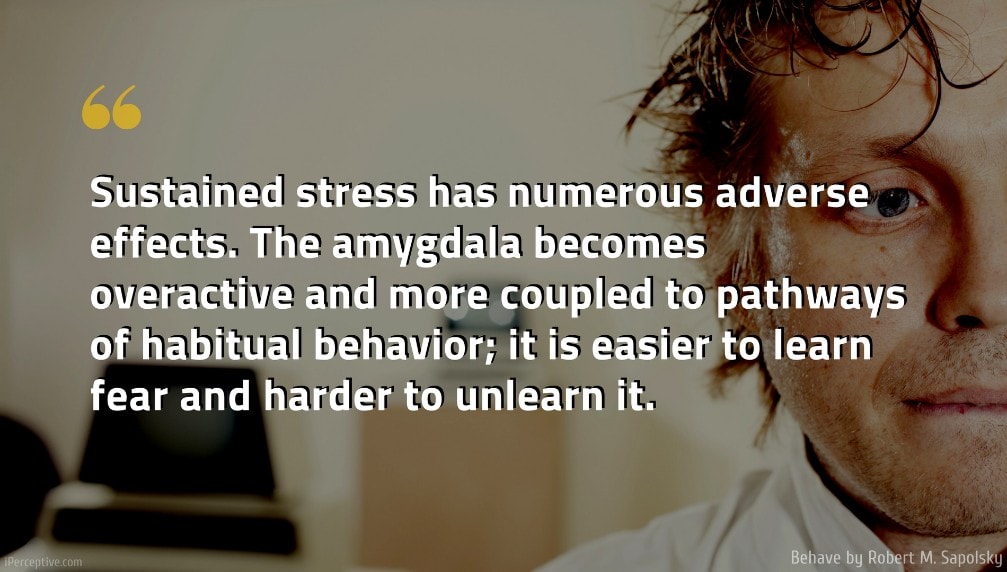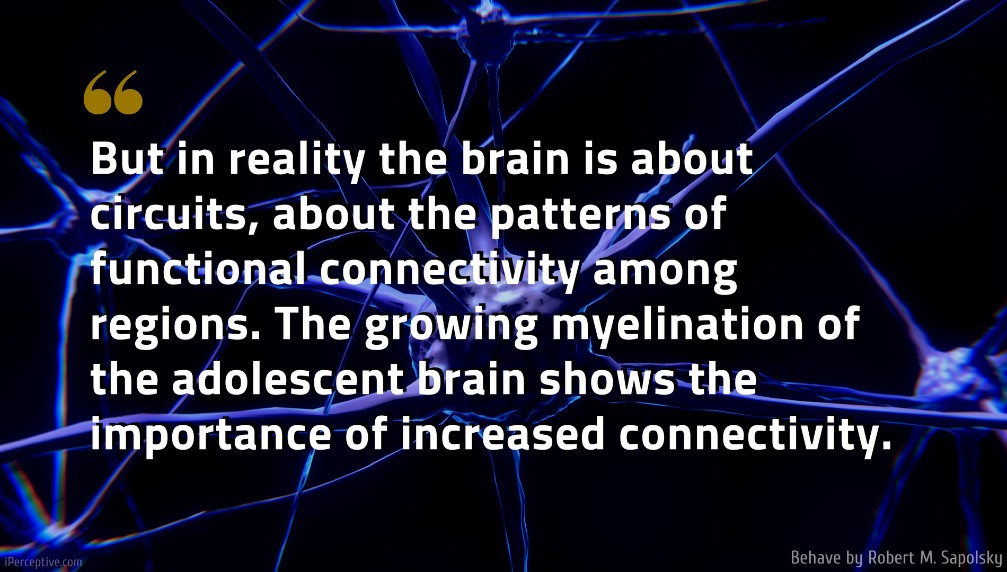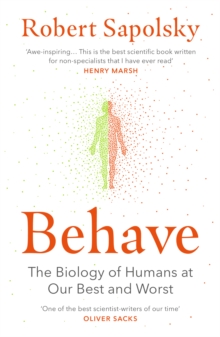Behave by Robert M. Sapolsky (Quotes and Excerpts)
Thought-provoking quotes, concepts and excerpts from the fascinating book on human behaviour and biology Behave: The Biology of Humans at Our Best and Worst by the American neuroendocrinologist and professor of evolutionary biology Robert M. Sapolsky.
If you wish to read the book in its entirety, here is a link to amazon

Sustained stress has numerous adverse effects. The amygdala becomes overactive and more coupled to pathways of habitual behavior; it is easier to learn fear and harder to unlearn it.
During sustained stress, the amygdala processes emotional sensory information more rapidly and less accurately, dominates hippocampal function, and disrupts frontocortical function; we’re more fearful, our thinking is muddled, and we assess risks poorly and act impulsively out of habit, rather than incorporating new data.
Stress can be bad for you. We no longer die of smallpox or the plague and instead die of stress-related diseases of lifestyle, like heart disease or diabetes, where damage slowly accumulates over time. It is understood how stress can cause or worsen disease or make you more vulnerable to other risk factors. Much of this is even understood on the molecular level. Stress can even cause your immune system to abnormally target hair follicles, causing your hair to turn gray.

Infuse oxytocin into the brain of a virgin rat, and she’ll act maternally—retrieving, grooming, and licking pups. Block the actions of oxytocin in a rodent mother, and she’ll stop maternal behaviors, including nursing.
For starters, circulating oxytocin levels are elevated in couples when they’ve first hooked up. Furthermore, the higher the levels, the more physical affection, the more behaviors are synchronized, the more long-lasting the relationship, and the happier interviewers rate couples to be.
Women with variants of genes that produce higher levels of oxytocin or oxytocin receptors average higher levels of touching their infants and more synchronized gazing with them.”

Pretty straightforwardly, the more categories of adversities a child suffers, the dimmer his or her chances of a happy, functional adulthood.
What happens when children observe domestic violence, warfare, a gang murder, a school massacre? For weeks afterward there is impaired concentration and impulse control. Witnessing gun violence doubles a child’s likelihood of serious violence within the succeeding two years. And adulthood brings the usual increased risks of depression, anxiety, and aggression. Consistent with that, violent criminals are more likely than nonviolent ones to have witnessed violence as kids.

But in reality the brain is about circuits, about the patterns of functional connectivity among regions. The growing myelination of the adolescent brain shows the importance of increased connectivity.
The brain is heavily influenced by genes. But from birth through young adulthood, the part of the human brain that most defines us (frontal cortex) is less a product of the genes with which you started life than of what life has thrown at you. Because it is the least constrained by genes and most sculpted by experience. This must be so, to be the supremely complex social species that we are. Ironically, it seems that the genetic program of human brain development has evolved to, as much as possible, free the frontal cortext from genes.

In a reductionist view, understanding something complex requires breaking it down into its components; understand those parts, add them together, and you’ll understand the big picture. And in this reductionist world, to understand cells, organs, bodies, and behavior, the best constituent part to study is genes.
You don’t have to choose between being scientific and being compassionate.

Novelty craving permeates adolescence; it is when we usually develop our stable tastes in music, food, and fashion, with openness to novelty declining thereafter.
Think about this—adolescence and early adulthood are the times when someone is most likely to kill, be killed, leave home forever, invent an art form, help overthrow a dictator, ethnically cleanse a village, devote themselves to the needy, become addicted, marry outside their group, transform physics, have hideous fashion taste, break their neck recreationally, commit their life to God, mug an old lady, or be convinced that all of history has converged to make this moment the most consequential, the most fraught with peril and promise, the most demanding that they get involved and make a difference. In other words, it’s the time of life of maximal risk taking, novelty seeking, and affiliation with peers. All because of that immature frontal cortex.

Dopamine is not just about reward anticipation; it fuels the goal-directed behavior needed to gain that reward; dopamine “binds” the value of a reward to the resulting work. It’s about the motivation arising from those dopaminergic projections to the PFC that is needed to do the harder thing (i.e., to work). In other words, dopamine is not about the happiness of reward. It’s about the happiness of pursuit of reward that has a decent chance of occurring.
So dopamine is more about anticipation of reward than about reward itself.
In other words, the default state is to trust, and what the amygdala does is learn vigilance and distrust.
Things that seem morally obvious and intuitive now weren’t necessarily so in the past; many started with nonconforming reasoning.
Being fearless, overconfident, and delusionally optimistic sure feels good. No surprise, then, that testosterone can be pleasurable.
Someone does something lousy and selfish to you in a game, and the extent of insular and amygdaloid activation predicts how much outrage you feel and how much revenge you take.
Perhaps fifty years since we learned that reading problems of a type that we now call dyslexia aren’t due to laziness but instead involve microscopic cortical malformations.
In a typical study, higher testosterone levels would be observed in those male prisoners with higher rates of aggression. But being aggressive stimulates testosterone secretion; no wonder more aggressive individuals had higher levels.
If you (or any other mammal) bite into rancid food, the insular cortex lights up, causing you to spit it out, gag, feel nauseated, make a revolted facial expression—the insular cortex processes gustatory disgust. Ditto for disgusting smells.
Thus, shorter refractory periods mean a higher rate of action potentials. So is testosterone causing action potentials in these neurons? No. It’s causing them to fire at a faster rate if they are stimulated by something else. Similarly, testosterone increases amygdala response to angry faces, but not to other sorts.
EVOLUTION RESTS ON three steps: (a) certain biological traits are inherited by genetic means; (b) mutations and gene recombination produce variation in those traits; (c) some of those variants confer more “fitness” than others. Given those conditions, over time the frequency of more “fit” gene variants increases in a population.
This is the essence of learning. The lecturer says something, and it goes in one ear and out the other. The factoid is repeated; same thing. It’s repeated enough times and—aha!—the lightbulb goes on and suddenly you get it. At a synaptic level, the axon terminal having to repeatedly release glutamate is the lecturer droning on repetitively; the moment when the postsynaptic threshold is passed and the NMDA receptors first activate is the dendritic spine finally getting it.
Cab drivers use spatial maps for a living, and one renowned study showed enlargement of that part of the hippocampus in London taxi drivers. Moreover, a follow-up study imaged the hippocampus in people before and after the grueling multiyear process of working and studying for the London cabbie license test (called the toughest test in the world by the New York Times). The hippocampus enlarged over the course of the process—in those who passed the test.
How does this work? Rodents produce pheromonal odors with individual signatures, derived from genes called the major histocompatibility complex (MHC). This is a super variable gene cluster that produces unique proteins that form a signature for an individual. This was first studied by immunologists. What does the immune system do? It differentiates between you and invaders—“self” and “nonself”—and attacks the latter. All your cells carry your unique MHC-derived protein, and surveillance immune cells attack any cell lacking this protein password.
When you get the news that everyone else disagrees with you, there is also activation of the (emotional) vmPFC, the anterior cingulate cortex, and the nucleus accumbens. This is a network mobilized during reinforcement learning, where you learn to modify your behavior when there is a mismatch between what you expected to happen and what actually did. Find out that everyone disagrees with you and this network activates. What is it basically telling you? Not just that you’re different from everyone else. That you’re wrong. Being different = being wrong. The greater the activation of this circuit, the greater the likelihood of changing answers to conform.
The dissociation between fear and aggression is evident in violent psychopaths, who are the antithesis of fearful—both physiologically and subjectively they are less reactive to pain; their amygdalae are relatively unresponsive to typical fear-evoking stimuli and are smaller than normal. This fits with the picture of psychopathic violence; it is not done in aroused reaction to provocation. Instead, it is purely instrumental, using others as a means to an end with emotionless, remorseless, reptilian indifference.
A behavior has occurred that is good, bad, or ambiguous. How have cultural factors stretching back to the origins of humans contributed to that behavior? And rustling cattle on a moonless night; or setting aside tending your cassava garden to raid your Amazonian neighbours; or building fortifications; or butchering every man, woman, and child in a village is irrelevant to that question. That's because all these study subjects are pastoralists, agriculturalists, or horticulturalists, lifestyles that emerged only in the last ten thousand to fourteen thousand years, after the domestication of plants and animals. In the context of hominin history stretching back hundreds of thousands of years, being a camel herder or farmer is nearly as newfangled as being a lobbyist advocating for legal rights for robots. For most of history, humans have been hunter-gatherers, a whole different kettle of fish.
This is central to understanding the nature of motivation, as well as its failures (e.g., during depression, where there is inhibition of dopamine signaling thanks to stress, or in anxiety, where such inhibition is caused by projections from the amygdala). It also tells us about the source of the frontocortical power behind willpower. In a task where one chooses between an immediate and a (larger) delayed reward, contemplating the immediate reward activates limbic targets of dopamine (i.e., the mesolimbic pathway), whereas contemplating the delayed reward activates frontocortical targets (i.e., the mesocortical pathway). The greater the activation of the latter, the more likely there’ll be gratification postponement. These studies involved scenarios of a short burst of work soon followed by reward. What about when the work required is prolonged, and reward is substantially delayed? In that scenario there is a secondary rise of dopamine, a gradual increase that fuels the sustained work; the extent of the dopamine ramp-up is a function of the length of the delay and the anticipated size of the reward.
Hunter-gatherer societies have typically been egalitarian, as we'll soon see, throughout hominin history. Inequality emerged when stuff, things to possess and accumulate, was invented following animal domestication and the development of agriculture. The more stuff, reflecting surplus, job specialization, and technological sophistication, the greater the potential inequality. Moreover, inequality expands enormously when cultures invent inheritance within families. Once invented, inequality became pervasive. Among traditional pastoralists or small-scale agricultural societies, levels of wealth inequality match or exceed those in the most unequal industrialized societies. Why have stratified cultures dominated the planet, generally replacing more egalitarian ones? For population biologist Peter Turchin, the answer is that stratified cultures are ideally suited to being conquerors. They come with chains of command. Both empirical and theoretical work suggest that in addition, in unstable environments, stratified societies are better able to survive resource shortages than egalitarian cultures by sequestering mortality to the lower classes. In other words, when times are tough, the unequal access to wealth becomes the unequal distribution of misery and death.
A remarkably consistent finding, starting with elementary school students, is that males are better at math than females. While the difference is minor when it comes to considering average scores, there is a huge difference when it comes to math stars at the upper extreme of the distribution. For example, in 1983, for every girl scoring in the highest percentile in the math SAT, there were 11 boys. Why the difference? There have always been suggestions that testosterone is central. During development, testosterone fuels the growth of a brain region involved in mathematical thinking and giving adults testosterone enhances their math skills. Oh, okay, it's biological. But consider a paper published in science in 2008. The authors examined the relationship between math scores and sexual equality in 40 countries based on economic, educational and political indices of gender equality. The worst was Turkey, United States was middling, and naturally, the Scandinavians were tops. Low and behold, the more gender equal the country, the less of a discrepancy in math scores. By the time you get to the Scandinavian countries it's statistically insignificant. And by the time you examine the most gender equal country on earth at the time, Iceland, girls are better at math than boys. Footnote, note that the other reliable sex difference in cognition, namely better reading performance by girls than by boys doesn't disappear in more gender equal societies. It gets bigger. In other words, culture matters. We carry it with us wherever we go.
Let’s see what “multifactorial” means in a practical sense. Consider someone with frequent depression who is visiting a friend today, pouring her heart out about her problems. How much could you have predicted the global depression and today’s behavior by knowing about her biology? Suppose “knowing about her biology” consisted only of knowing what version of the serotonin transporter gene she has. How much predictive power does that give you? As we saw in chapter 8, not much—say, 10 percent. What if “knowing about her biology” consists of knowing the status of that gene plus knowing if one of her parents died when she was a child? More, maybe 25 percent. How knowing her serotonin transporter gene status + childhood adversity status + whether she is living alone in poverty? Maybe up to 40 percent. Add knowledge of the average level of glucocorticoids in her bloodstream today. Maybe a bit more. Toss in knowing if she’s living in an individualist or a collectivist culture. Some more predictability. Know if she is menstruating (which typically exacerbates symptoms in seriously depressed women, making it more likely that they’ll be socially withdrawn rather than reaching out to someone). Some more predictability. Maybe even above the 50 percent mark by now. Add enough factors, many of which, possibly most of which, have not yet been discovered, and eventually your multifactorial biological knowledge will give you the same predictive power as in the fractured-bone scenario. Not different amounts of biological causation; different types of causation.

